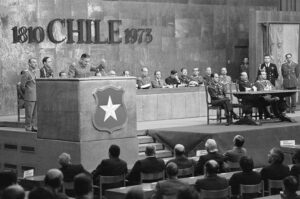This article is adapted from AQ’s special report on A (Relatively) Bullish Case for Latin America
BUENOS AIRES — On the popular Instagram account known as the “Walking Conurban,” a photo from the warmest winter on record in the Buenos Aires area shows a makeshift pool on a sidewalk beside a ramshackle house. In other images, symbols of Western mass culture, like Disney characters and Minions (from the 2010 film Despicable Me), appear in crude, altered form on shabby suburban streets.
For its half a million followers, the Walking Conurban account celebrates the scrappy ethos of life in the sprawling conurbano, the string of 24 mostly poorer municipalities that surround Buenos Aires city. In capturing its unique culture and the stark contrast it forms with the wealthy, cosmopolitan capital city, these photos also serve as a reminder of the strange space the conurbano represents in the national psyche—separate, but all-important.
According to journalist Carlos Pagni, the area is critical to understanding the current paradigm of Argentine politics and its potential demise. Pagni’s best-selling book, El nudo: por qué el conurbano bonaerense modela la política argentina, released before primary elections in August, delves deep into the region’s history and its political relevance.
The streets of the conurbano are a prime site for political campaigns, where national politicians roam to show their connection to real people. The area is home to 10.9 million people, making the Buenos Aires metropolitan region one of the largest in the world. And boasting a quarter of Argentina’s inhabitants, it’s an electoral juggernaut that can make or break an election. It is the cradle of Peronism and the key to the movement’s decades of political dominance.
The PASO primary elections on August 13 left the conurbano as one of Peronism’s last bastions—with the Unión por la Patria coalition taking 37% of the conurbano vote—but also showed that its support is cracking. The movement lost more than a million votes in the area compared to its victory in the 2019 election.
But here, too, inroads have been made by the angry, anti-political discourse represented by libertarian Javier Milei, the upstart who won 30% of the national vote in August primaries, surpassing predictions to become the highest vote-getter. In the conurbano he came in third, but with a strong showing: 26% of the vote.
This is a sign of the deep-seated nature of Argentina’s economic crisis, with half the country living in poverty and triple-digit inflation that is still rising. When AQ went to press, Argentines had yet to vote in the October 22 presidential election, but the surprise upset by an outsider candidate in the primaries reflects widespread exhaustion with the political status quo on both sides of the political divide.
For Pagni, the conurbano is not just a place, but also the embodiment of the rise and fall of “a social, productive and labor system” defined by Peronism’s industrial and welfare policies. He describes a self-defeating, exhausted model in which politicians must respond to electorally relevant but short-term concerns in the region at the cost of national, long-term growth by favoring a strong peso and consumption over export-friendly policies, a strategy whose diminishing returns have morphed Argentina into a “machine that produces poor people.”
The need to address the short-term concerns of the conurbano’s population is underlined by its power to insert itself into national politics in a direct, emphatic manner. For Pagni, this power is exemplified by two popular eruptions: the famous 1945 workers’ march to Plaza de Mayo that launched Peronism as a political movement and concentrated the conurbano’s political clout, and the 2001 protests and looting that showcased the chaos-producing potential of the region’s discontent.
Fear of a return to the collapse of 2001 has characterized Argentine politics for two decades. But instead of tackling the material causes of the discontent of 2001, President Néstor Kirchner and his successor Cristina Fernández de Kirchner simply managed the chaos by revamping Peronism. Where classic Peronism had found electoral support in the industrial working class, the Kirchners built a political empire on the unemployed masses that formed in the wake of the destruction wreaked by neoliberalism in the 1990s. But in the end, this proved self-defeating, Pagni contends. Thanks to the “imbalances” it gave rise to, the “economic policy of short-term distributism eventually generated, once again, the very discontent it had promised to avert.”
The conurbano’s centrality in the current political paradigm might explain why support for the disruption represented by Milei is weaker here: The area is benefited by the political divide (or grieta), and is far from the “geography of discontent” that some analysts have used to explain support for the libertarian candidate in some of the country’s poorest areas, far from Buenos Aires.
But even here, the desperation and lack of political representation that characterized the 2001 explosion have become relevant again, with voters tormented by an economic crisis that both dominant political factions have failed to resolve. This year could signal the end of a two-decade cycle tied to the 2001 crisis. But if October ushers in a new political era, it likely begins in the fires of its very own cataclysm.
—
Timerman is a freelance reporter in Buenos Aires. She edits the Latin America Daily Briefing newsletter.










